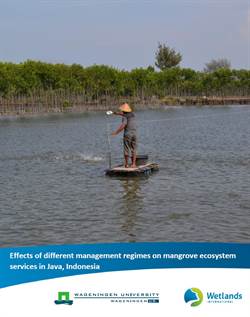
Effects of different management regimes on mangrove ecosystem services in Java, Indonesia
-
Coastal resilience
-
Coastal wetland conservation
-
Integrated delta management
This report for the first time quantifies the provision of mangrove ecosystem services according to different management regimes. The study concludes that ecosystem service provision depends strongly on the type of management and that mangrove-rich management regimes generally outscore aquaculture regimes. Decision-makers can make management choices depending on the desired outcome in terms of ecosystem services.
Description
This new report, published by Wageningen University and Wetlands International, seeks to fill a significant gap in mangrove ecosystem service estimates. While several studies have sought to measure and value the ecosystem services provided by mangrove ecosystems in general, this new piece of research has for the first time conducted separate evaluations for zones that are characterised by distinct management activities – so-called ‘management regimes’, which include protected, rehabilitated, silvo-fishery and converted mangrove systems.
The analysis conducted for the report served as the basis for a peer reviewed article on the journal Ocean & Coastal Management.
Some of the study’s findings include:
- All management regimes with some mangroves outperform aquaculture regimes in terms of number of ecosystem services provided.
- Aquaculture only provides one single service (food provision), but this largely depends on artificial production and jeopardizes other services (carbon storage, coastal protection, water purification).
- Although aquaculture systems (almost entirely artificial) and mangrove systems (natural) are difficult to compare, the study found that fishery yields in more natural mangrove systems compare in magnitude (in terms of kg/ha/yr) to aquaculture, while also providing additional benefits. However, this may entail a wide variety of species in the case of mangroves while aquaculture delivers specific target species.
- Mangrove tree age (and related height, diameter, root length, species richness and structural complexity) were found crucial for all seven ecosystem services analysed in the study.
- There are at least 9 varieties of silvo-fisheries, which differ widely in terms of ecosystem service provisioning. The ones that perform best have separate inlets and outlets, and separate parts for forestry and fishing, which optimises functionality.
- Eco-certification has great potential (in view of greenbelt and rehabilitation requirements) but can still have negative impacts on other services unless management is adjusted.

